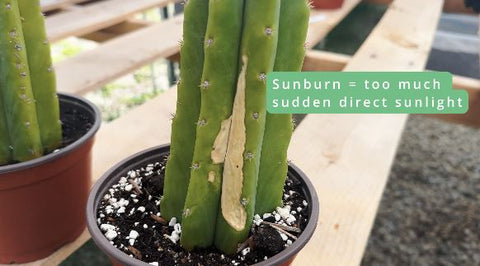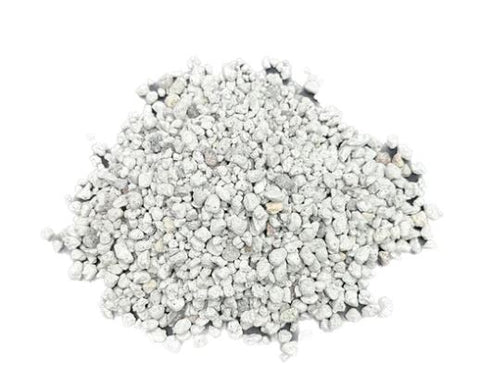How to Grow a San Pedro Cactus [Updated 2024]
Basic San Pedro Cactus Care 101
The San Pedro Cactus, scientifically named Trichocereus pachanoi or Echinopsis pachanoi, is a columnar cactus originating from the Andes Mountains. Renowned for its longevity and resilience, this cactus exhibits fast, upward and outward growth. Cultivated for its hardiness, the San Pedro Cactus is recognized for its symbolic representation of strength and resilience.
In this blog, we are going to go over the basics of how to keep your San Pedro thriving and happy, including: light, soil, and water needs, temperature and humidity, fertilizer, pest control, and propagation.
Optimizing Light Conditions for San Pedro Cactus
San Pedro wants full sunlight. If you’re growing this cactus outdoors then find a spot that gets at least 6 hours of sunlight daily. If growing indoors then find a spot in your home like a south or west facing window where it can receive as much sunlight as possible. If you lack enough light in your home then a grow light can be greatly beneficial, and maybe even necessary, to supplement the lack of sunlight. Make sure to observe your cactus for signs of etiolation (skinny growth and leaning stems) from not enough light or sunburn (brown spots) from too much direct sunlight too quickly.


Tip: if your San Pedro has been in partial light, then it might be good to slowly introduce it to more full sun to reduce the risk of burn. Consider growing in a greenhouse for additional protection.
Soil Tips and Repotting Guide for Healthy Growth
If planting a San Pedro in a pot then make sure to use well-draining soil and a pot with drainage. A healthy amount of pumice can be added to a commercial cactus soil mix to create optimal drainage for this plant and help prevent rot. We suggest a ratio of roughly 40-50% percent inorganic material like perlite or horticultural pumice to organic material such as peat moss and coco coir.

If you’re planting this in an outdoor garden then make sure to test the soil to see how well it drains and amend with extra draining as needed. These cacti require some support, so plant them deep in soil so that they can anchor themselves well and have stability.
Tip: A smaller cactus can be repotted every few years to give it the room it needs to continue its fast growth.
Watering Techniques for Thriving San Pedro Cacti
Watering San Pedro cacti is more about frequency than the amount. San Pedro cactus are fast vigorous growers and typically want more water in the growing season compared to most cactus. We suggest using a soak and dry method and monitoring the cactus for signs of when to water. The soil will be completely dry, and the cactus should look shriveled with skinnier ribs. When it is ready, give the cactus a healthy, full soak. Always let the soil dry out completely before watering again. While the predominant cultivar San Pedro can be pretty forgiving when it comes to overwatering, it’s always best to lean towards underwatering, especially in the cooler winter months.

Tip: If planted outdoors, Consider your local climate and adjust watering accordingly, especially during the rainy season.
Managing Temperature for Ideal Cactus Health
San Pedro cacti love a warm sunny environment and will thrive in the hotter spring and summer months, growing rapidly and producing many offsets. San Pedro are prone to frost damage, especially at the tips, and they do poorly below 30° Fahrenheit and above 90F. If the environment becomes too cold, consider bringing your plants inside (if possible) or try using a frost blanket to protect them.
San Pedro will also be affected by heat stress at higher temperatures, and will turn more yellow in color. This might be all over, on one side, or in splotchy areas.
Understanding Humidity in San Pedro Cactus Care
San Pedro Cacti don’t like overly humid environments, so make sure to keep your cactus in a place that has good airflow to prevent too much moisture from collecting and potentially causing rot or fungal issues. This is crucial in greenhouses and indoor settings. The predominant cultivar is pretty disease and fungal resistant, making it a great starter plant.

Fertilizer Application for Robust Cactus Growth
The best time to fertilize San Pedro cacti is during their growing season in the spring and summer, as this will further enhance their fast growth during this time. We recommend regularly using a liquid fertilizer during the growing season, and mixing it in about every other watering. We recommend avoiding nitrogen rich fertilizers. Typically a ratio with more phosphorus and potassium is preferred.
Pest Prevention and Control Strategies
Regularly inspect your cacti for signs of pests. San Pedro cacti can be especially susceptible to scale, but can also be attacked by snails and sucker bugs, as well as mealybugs and mites. Early detection can help prevent infestations from becoming severe. 70%+ isopropyl alcohol can be used to treat affected areas from most pests so use as needed.


Tip: If the infestation is severe, consider pruning and removing heavily affected parts of the cactus. You can then focus on growing the healthy sections that remain.
Successful Propagation Methods for San Pedro Cacti
San Pedro are amazing in their ability to be cut while continuing to grow, like a starfish regrowing limbs. Propagating San Pedro cacti can be a great way to expand your cactus collection, to salvage healthy portions of dying plants, or to give cactus cuttings as gifts. You can propagate by cuttings, by seeds, or by grafting on to other cactus.

For a more in-depth guide on how to propagate San Pedro cacti, you can check our guide on ‘Taking a Cactus Cutting’ here. We also have a step-by-step guide on crafting cacti here.
Conclusion
This guide has covered essential aspects of caring for the San Pedro Cactus, shedding light on the nuances of cultivating Trichocereus pachanoi, or Echinopsis pachanoi. From optimal light exposure and well-draining soil to watering techniques, temperature considerations, and pest control, we've delved into the key factors that contribute to the well-being of your San Pedro.
Whether you're a seasoned cactus enthusiast or a beginner, we hope this blog post has equipped you with valuable insights into nurturing these resilient and beautiful plants. Remember to adapt your care routine to the specific needs of your San Pedro, considering factors like local climate and seasonal variations.
